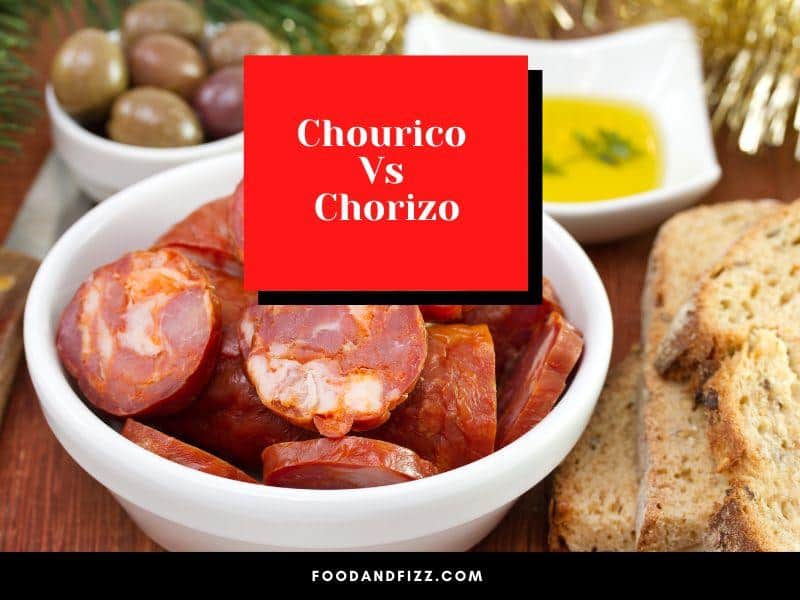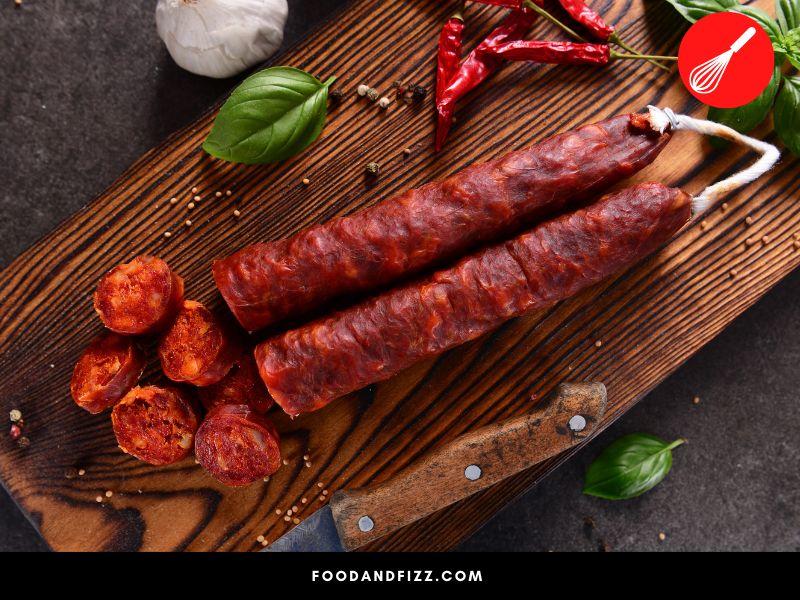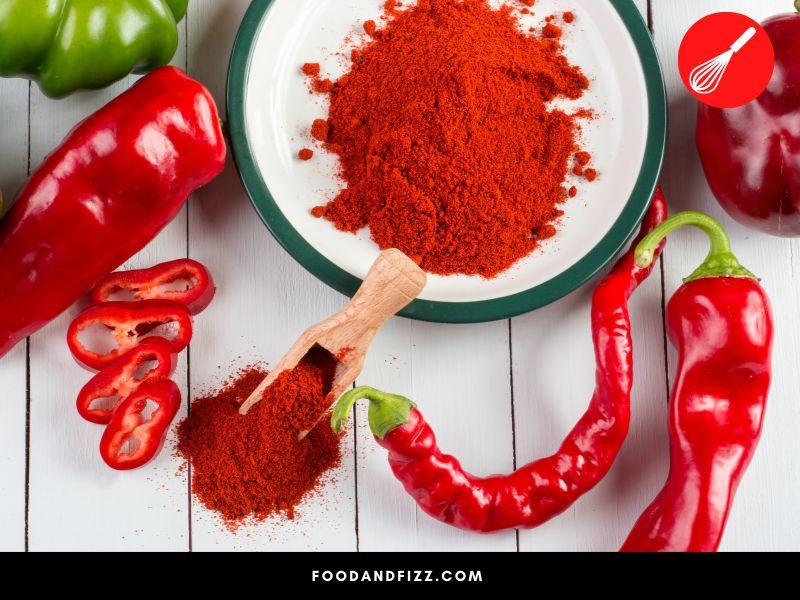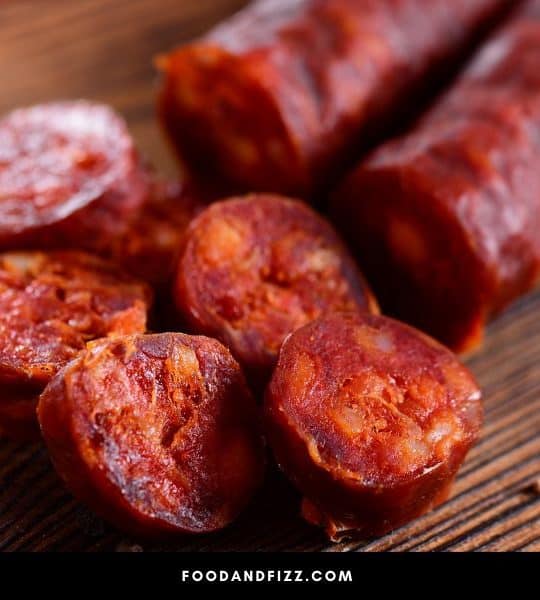Chourico and chorizo are two similar sounding names and it is easy to conclude that they mean the same thing, that is, a cured pork sausage.
But is this really the case? Is chourico and chorizo just two names referring to the same thing or are they completely different meat products?
Chourico vs Chorizo
Chourico and chorizo are both spiced pork sausages, but the ingredients and seasonings used to make them are slightly different. Chourico is a Portuguese sausage that is smoked and fully cooked, while chorizo is a Spanish sausage that is fermented, cured, smoked, or unsmoked. Mexican variations of chorizo are fresh and uncured.

The Difference Between Chourico and Chorizo
It is easy to confuse the two terms as they sound similar, and both pertain to cured pork sausages typically made with pork shoulder. However, a closer look at them reveals that they have notable differences.
We’ll explore them below.
Origins
Chorizo originated in Spain, while chourico originated in Portugal. In the U.S., chorizo is arguably the more popular kind of pork sausage. A variation, Mexican chorizo, is also very popular.
Ingredients and Seasonings
Both chourico and chorizo are made with pork and feature ingredients like paprika, garlic, salt, and pepper, but the proportions are very much different.
Spanish chorizo has lots more paprika in it compared to chourico. Chourico on the other hand, has considerably more garlic and pepper than chorizo.
Another interesting feature of chourico is that Portuguese red wine is added to the mix to round out the flavor.
Mexican chorizo is also typically made with pork but can be made with beef, chicken, turkey, or lamb. As Spanish smoked paprika can be hard to find and expensive, Mexican chorizo is typically made with local varieties of chili peppers.
An interesting variety of Mexican chorizo is called chorizo verde which is made with green tomatillo and cilantro.

Method of Processing
Spanish chorizo is typically cured and may be smoked or unsmoked depending on the type and region where it is made, while Portuguese chourico is almost always smoked and fully cooked.
Mexican chorizo though is not cured at all and is always sold fresh. Because of this, Mexican chorizo must always be cooked before consuming.
Spice Level
Portuguese chorico is spicier than typical Spanish chorizo, but Mexican chorizo is spicier than both Portuguese chourico and Spanish chorizo. While similar, chourico and chorizo are two very distinct types of pork sausages.
While they feature similar ingredients, the proportions are quite different, and depending on the region where it is from, regional ingredients may also be added, making them even more distinct and unique from each other.
What is Chorizo? – A Closer Look
Chorizo is a spicy pork sausage that originated in Spain and is common in countries with Hispanic influence, like Mexico, Latin America, and the Philippines.
Spanish Chorizo
Traditional Spanish chorizo is made with pork, fat, smoked paprika (called pimenton), garlic, salt, and pepper. Regional differences exist, which may include added herbs and spices.
In general, though, the most important ingredient in chorizo is the pimenton or paprika, which gives it its characteristic reddish hue, and is what determines whether it is “picante” (spicy) or “dulce” (sweet).
Spanish chorizo is typically dried, fermented and cured, and sometimes smoked. It can usually be consumed without further cooking. It is what usually comes to mind when we think of Spanish tapas.
It can be consumed as is as part of a cheese and charcuterie board, or crisped up and added to other dishes to enhance flavor. It can also be added to popular dishes like Paella.

Some Varieties of Spanish Chorizo
- Chorizo Riojano – Made in the La Rioja region of Spain. Known for its horseshoe shape and smooth, balanced flavor of mostly garlic and pepper. It contains no additives and is a product with Protected Geographical Indication status.
- Chorizo de Pamplona – From the Navarre region in Spain. One of the first to be industrially produced. It is dried, cured, and fermented and it has been said to be similar to pepperoni.
- Chorizo de Leon – Very spicy chorizo with a deep red hue due to the heavy use of pimenton. It is also in a horseshoe shape and is cured and smoked.
- Chorizo de Cantimpalos – Also PGI-protected and known as one of the oldest chorizos, and the most versatile. The pigs used to make this must be fed a specific diet and the air-drying process must also meet the traditional standards.
- Chorizo de Cantabria – A popular sausage in Spain that is smoked and features oregano and thyme as added ingredients.
Mexican Chorizo
Mexican chorizo is another type of chorizo that is popular in the U.S. Unlike its Spanish counterpart, Mexican chorizo is almost always fresh and uncured. This means that it should always be cooked prior to consumption.
While it is predominantly made of pork, other versions made with beef, lamb, chicken or turkey exist. The flavors of Mexican chorizo are more diverse, and herbaceous varieties are common.
Regional ingredients also play a major role, and depending on what ingredients are used, they look very different from their Spanish cousin.
An example is Chorizo Verde, which is green when uncooked due to the use of green tomatillo and cilantro, and other green herbs as ingredients.
Mexican chorizo can be made with or without the casing. Compared to Spanish chorizo, Mexican chorizo is generally much spicier.
Some popular ways to use Mexican chorizo include:
- Chorizo Con Papas – Sausage mixed with potatoes
- Queso Fundido – Melted Cheese Dip
- Chorizo Con Huevos – Chorizo with Eggs
- As toppings for Nacho, Pizza
- Filling for tacos and burritos
There are many different types of chorizo and many different flavors and seasonings used, depending on where it is made.
It is pretty fascinating to see how something that started from just three or four simple ingredients can be adapted to suit different tastes and cultures, and also how those same four ingredients are still used to make classic and traditional Spanish chorizo to this day.

What is Chourico? – A Closer Look
Chourico is a Portuguese pork sausage that is often confused with the Spanish chorizo. While they may look similar, chourico and chorizo are actually different things.
Like chorizo, chourico is also made from pork, paprika, garlic, salt, and pepper but the proportions are quite different.
Spanish chorizo has considerably more paprika in the mix compared to chourico, and chourico has way more garlic in it. Besides this, chourico also typically has red wine added into the mix.
How Is Chourico Made
While Spanish chorizo can be dried, cured, and fermented and it can be smoked, or unsmoked, and Mexican chorizo is always sold raw and fresh, Portuguese chourico is typically always smoked and fully cooked when sold.
It is packed into meat casings, dried slowly, and smoked to full flavor. Additional seasonings may be added, like cinnamon, Piri-piri, or cumin.

Popular Uses for Chourico
A popular and traditional way to have chourico is in a dish called Chourico a Bombeiro.
It basically means “flame-grilled”. Chourico is grilled on top of a special clay vessel and blackened to give it a crispy texture. Alcohol may be added to char it even further.
Other ways to use chourico include: adding it to soups and stews, using it in frittatas, or adding them to potato balls. It is also something that goes well with clams.
Read Next: What Is Sausage Made Of?
Frequently Asked Questions About Chorico vs Chorizo
Is Spanish Chorizo the Same as Mexican Chorizo?
Spanish chorizo and Mexican chorizo are different. Mexican chorizo was derived from Spanish chorizo but regional ingredients and methods of preparation have slowly changed it to make them two completely different products. Spanish chorizo is typically fermented and cured and sometimes smoked. Mexican chorizo is fresh and needs to be fully cooked before eating.
Can You Substitute Portuguese Chourico for Spanish Chorizo and Vice Versa?
In recipes such as stews or soups or other recipes where they are just add-ins, they can probably be substituted for each other without much variation in taste and texture. If they are the star of the show, for example in a charcuterie board, the flavor differences will be more apparent.
Conclusion to Chourico vs Chorizo
Chourico and chorizo may often be lumped together but it is interesting to note that they are actually different and distinct products.
While they share similarities in their ingredients, they differ in how those ingredients are portioned and mixed and differ in their methods of preparation.
It is also pretty interesting to note that, depending on where the sausages are produced, regional differences in ingredients, method, presentation, and use are very much evident in the final product.

